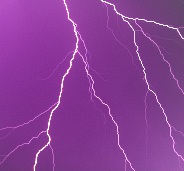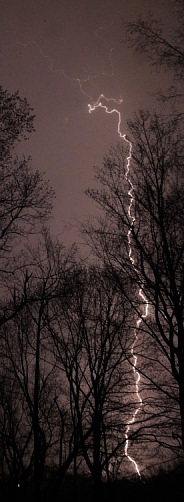
Ultraviolet photo of lightning
 e've known for a long time that lightning emits light well into the ultraviolet
range. This is just thermal emission like you'd see in a halogen bulb. It's not
enough to give you a lightning tan, but it's easy to take ultraviolet pictures
of lightning like the one shown at right.
e've known for a long time that lightning emits light well into the ultraviolet
range. This is just thermal emission like you'd see in a halogen bulb. It's not
enough to give you a lightning tan, but it's easy to take ultraviolet pictures
of lightning like the one shown at right.
In the past few decades, we've learned some unexpected things about thunderstorms: sprites, elfs, and blue jets that shoot up into space. But perhaps even stranger is the discovery that thunderclouds also produce radioactivity in the form of X-rays and gamma rays[1,2,3] and even antimatter.
Terrestrial gamma ray flashes
The gamma ray emissions are called terrestrial gamma-ray flashes, or TGFs. They're so intense that special detectors are needed to handle the number of counts, which can approach 100,000 counts per second. They can be bright enough that it's even been suggested that they could pose a radiation hazard to passengers in aircraft.

Infrared photo of lightning
TGFs are easy to detect from satellites, but they can also be detected on the ground. A particularly interesting example is in a 2009 paper in the Journal of Plasma Fusion Research by Enoto et al.[4]. They took two NaI (sodium iodide) scintillators, attached them to photomultiplier tubes, and shielded them with a layer of Bi4Ge3O12, a substance that absorbs cosmic rays and background radiation below 2.6 MeV. As is commonly done, the two detectors were hooked up in an anti-coincidence circuit that blocks any noise pulses unless they appear in both detectors.
They took the detectors up into the mountains in Niigata Prefecture, where winter thunderstorms are particularly close to the ground. They detected gamma rays, and not just a few: during a lightning storm their detector registered 10 counts per second, for a total of 130 counts, which is well above background.
Runaway electrons
This amount of radiation is not nearly enough to be harmful. But how could thunderstorms produce radioactivity? Physicists theorize that an avalanche reaction of electrons in the cloud in a strong electric field speeds them up to some fraction of the speed of light. When these charged particles come close to the nucleus of some atom in the atmosphere, their paths curve, causing them to slow down and give off a type of radiation called bremsstrahlung (‘braking radiation’).
This is called a relativistic runaway electron avalanche (RREA) and it requires a trigger or ‘seed particle’ like a cosmic ray or a stray radioactive atom. In some ways it resembles what happens in a Geiger counter: the electrons are all sitting around in an energetic state, waiting for something to come along and release their energy.
In their book on the physics of lightning, Rakov and Uman say that runaway electrons are also the cause of sprites. Unlike sprites, where the electrons run upward, when the trigger is a cosmic ray the electrons have to runaway toward the ground, the same direction as the cosmic ray.[5] This would mean that sprites must be triggered by radioactive atoms. It also means the TGFs occur at much lower altitude than sprites.
There's also something called a gamma ray glow, which is much fainter. Gamma ray glows last up to a minute (compared to 400 μs for a TGF), and lightning stops them[6]. Bremsstrahlung is the widely accepted explanation for gamma ray glows as well as TGFs. The unique thing about bremsstrahlung is that its spectrum looks like a continuum instead of distinct peaks because the electrons can approach a nucleus in any number of ways. Unlike most other kinds of light that have continuous spectra, though, it's not caused by heat. This is important because a continuum can be subtracted out to reveal the antimatter signature (see below).
All this is quite different from the much bigger and longer duration flux of gamma rays caused by atmospheric radon that's associated with rain or snow. But nobody is really very interested in that.
Thunderclouds lives antimatter
When a gamma ray comes close to a nucleus, it can produce an electron and a positron (anti-electron) by a process called pair production. The electrons go their merry way, but the positrons are quickly annihilated by colliding with another electron. Thus, the characteristic signature of antimatter is a gamma ray peak at 511 keV caused by annihilation of electrons and positrons. Nobody detected that in a thundercloud until 2015, when Dwyer et al. [7] flew a Gulfstream V jet into a Florida thunderstorm.
They reported that the plane experienced “rapid altitude changes,” but no lightning strikes, and then suddenly they found themselves immersed in a cloud of radiation at least half a kilometer in diameter. It sounds like that time I flew on Allegheny, and I think there was something walking on the wing.
While in the radioactive cloud they picked up four bursts of gamma rays up to 11,000 counts per second. At the same time, their low-gain radio antenna got shorted out by an electric spark. When they analyzed the gamma rays, they found a small but definite peak with an intensity of only twelve times background level, but it was at 511 keV—the unmistakable signature of antimatter. They estimated that the total amount of radiation from positrons was around 18 Curies (666 GBq)—roughly equivalent to 20 million smoke detectors.
That might sound like a lot, but if it was a point source, you would have to be 1.134 meters or 44.6 inches away from it to get same exposure rate from positrons as a dental X-ray machine. However, the positrons are only a tiny fraction of the total radiation; Dwyer et al. estimated[11] that a passenger on an aircraft flying through a big TGF might theoretically get up to 10 rem (0.1 Sv), or 5000 times that of a dental X-ray (27 times the annual background exposure).* That's enough to make your hair stand on end.
Almost all of the risk comes from the electrons, not from gamma rays or antimatter. Beta particles are electrons that are shot out from radioactive atoms. But in terms of their effects on the human body, beta particles are indistinguishable from ordinary electrons that have been accelerated to relativistic speeds in a high voltage gradient. Beta particles can be absorbed by the metal skin of an airplane, but a better way to stop them is with a half inch of plastic. The fat guy sitting in the window seat next to you is also a pretty good absorber.
In layman's terms this means that the electrons in strong electric fields in thunderclouds are exactly like radioactive beta-particles. Getting too close to them could be bad for you.
Antimatter may seem exotic, but 0.001% of the time the naturally radioactive potassium-40 in your body decays by emitting positrons as well. That means every man, woman, and child is emitting small amounts of antimatter from 40K disintegration. Every banana contains a small amount of antimatter.
Neutrons
Gamma rays can also create neutrons, either by nuclear fusion or by something
called a photonuclear reaction, which needs a photon above 10.5 MeV:
Fusion of deuterium: 2H + 2H → n + 3He
Photonuclear reaction: 14N + γ → n + 13N.
It's unlikely that there'd be nuclear fusion in lightning. But in the past couple years, several articles have indeed reported neutrons from thunderclouds, detected on the ground[8,9] using neutron monitors. However, there's some dispute[10] about this, because neutron monitors have a low but non-negligible sensitivity to gamma rays above 7 MeV, because high-energy gamma rays can produce neutrons when they pass through lead, which surrounds the detector.
Neutrons are harder to detect than gamma rays, because once they're released from the nucleus they become unstable. They decay to a proton, an electron, and an electron antineutrino with a half-life around 15 minutes:
n → p+ + e− + νe
Neutrons also get absorbed into other elements by a process called neutron capture (which can make them radioactive), and they're also easily scattered. An important nuclear reaction in the atmosphere is a collision with nitrogen to produce carbon-14 and a proton:
1n + 14N → 14C + 1H
So in order to detect them, you'd have to be fairly close to the source. But it looks like the jury is still out on whether thunderstorms really produce significant numbers of neutrons.
* The calculations come from a computer model that assumes that the exposure is due to a beam of high-energy electrons passing through the 0.25 inch aluminum skin of the aircraft during a large TGF. The authors estimated that exposure from gammas would be 15 times lower than for electrons. The effective dose from an ordinary lightning strike would be much lower.
Update: I took a Radalert 50 outside during a recent thunderstorm. It measured the following counts/minute at one-minute intervals:
| Time | Counts / minute |
|---|---|
| Before | 14 |
| At Peak | 23 |
| Subsiding | 17 |
| After | 12.95 ± 3.46 (N=23) |
The 23 is statistically significant (p=0.0037, two-tailed), but the clicks did not correlate to the lightning flashes. It seems my detector is not sensitive enough. Or maybe I need to get closer.
Update, Apr. 11 2017 Got a violent thunderstorm, counts/minute increased from 11 to 21, slowly decreasing after the rain stopped but still not correlated with lightning. Just ordinary radon.
References
1. Parks, G. K., Mauk, B. H., Spiger, R. and Chin, J. 1981 X-ray enhancements detected during thunderstorm and lightning activities. Geophys. Res. Lett. 8, 1176–1179.
2. Moore, C. B., Eack, K. B., Aulich, G. D. and Rison, W. 2001 Energetic radiation associated with lightning stepped-leaders. Geophys. Res. Lett. 28, 2141–2144.
3. Dwyer, J. R. et al. 2003 Energetic radiation produced during rocket-triggered lightning. Science 299, 694–697.
4. Enoto T, Tsuchiya H, Yuasa T, Yamada S, Kato H, Kawaharada M, Kitaguchi T, Kokubun M, Okano M, Nakamura S, Nakazawa K, Makishima K (2009). Observations of high energy gamma-rays from winter thunderclouds. J. Plasma Fusion Res. 8, 208–211.
5. Rakov VA, Uman MA (2003). Lightning: physics and effects. Cambridge, p.494.
6. Eack, K. B., Beasley, W. H., Rust, W. D., Marshall, T. C. and Stolzenburg, M. (1996). Initial results from simultaneous observation of x rays and electric fields in a thunderstorm. J. Geophys. Res. 101(D23), 29637–29640.
7. Dwyer JR, Smith DM, Hazelton BJ, Grefenstette BW, Kelley NA, Lowell AW, Schaal MM, Rassoul HK (2015). Positron clouds within thunderstorms. J Plasma Physics 81,1–17.
8. Kuroda Y, Oguri S, Kato Y, Nakata R, Inoue Y, Ito C, Minowa M (2016). Observation of gamma ray bursts at ground level under the thunderclouds. arXiv:1601.06349v3.
9. Tsuchiya H, Hibino K, Kawata K Hotta N, Tateyama N, Ohnishi M, Takita M, Chen D, Huang J, Miyasaka M, Kondo I, Takahashi E, Shimoda S, Yamada Y, Lu H, Zhang JL, Yu XX, Tan YH, Nie SM, Munakata K, Enoto T, Makishima K (2012). Observation of thundercloud-related gamma rays and neutrons in Tibet. arXiv:1204.2578v1.
10. Tsuchiya H (2014). Surrounding material effect on measurement of thunderstorm-related neutrons. arXiv:1403.7597v1.
11. Dwyer JR, Smith DM, Uman MA, Saleh Z, Grefenstette B, Hazelton B, Rassoul HK (2010). Estimation of the fluence of high-energy electron bursts produced by thunderclouds and the resulting radiation doses received in aircraft. J Geophys Res 115, D09206. doi:10.1029/2009JD012039.
Last updated mar 16 2017, 2:41 am
Related Articles
Photographing radioactivity with a webcam

science
commentary
book reviews
home